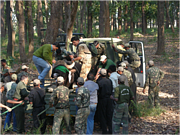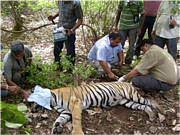India National Committee of IUCN Members
01 August 2012 | Article
The Indian National Committee is a forum of IUCN members in India. It was granted formal recognition by IUCN Council at its 55th meeting held in Gland, Switzerland which was communicated vide IUCN HQ Letter No. IN/4/NC55 dated 14 November, 2001. The mandate of the Committee is to coordinate activities of IUCN members in India to evolve common approach on relevant conservation issues. The members of the Committee bring with them expertise and knowledge in various areas of nature conservation. It is thus a forum having collective wisdom on issues relating to conservation of nature and natural resources.
Currently, there are 29 Members in the Committee drawn from Government of India, Scientific Institutions and National and International NGOs. The expertise represented in the Committee include policy planning, wildlife enforcement and management, scientific research, capacity building of personnel engaged in management of natural resources, disaster management, urban landscape management and livelihood issues.
During the period 2008-2012, the Indian National Committee members had four formal meetings on 28 October 2009, 21 March 2011, 16 March 2012 and 24 July 2012. The issues on which Members deliberated including presentation by IUCN India Office on progress on India programmes, mechanism for greater involvement of IUCN Members in the India country programme, participation in CBD COP-11 at Hyderabad, initiative of Bombay Natural History Society for involving Civil Society organizations for COP-11, discussion of motions and resolutions proposed at the IUCN World Conservation Congress, Jeju and participation of membership in discussions.
The activities of the membership which have contributed to conservation action both at local level as well as decision making level on various conservation related issues are given below:
- Mapping of around 600000 sq. km. of Tiger Range landscape in India in GIS domain to estimate its population, occupancy, corridor connectivity among source areas and relevant habitat attributes.
- Reintroduction of large mammals viz. Tiger, Gaur (the Indian Bison) and Rhino as part of species recovery programme.
- Initiating cumulative assessment studies on impact of developmental projects on environment for mainstreaming biodiversity conservation in such projects. The sector covered under this approach for decision making include hydro power and irrigation projects, linear developmental projects (roads) and oil exploration in coastal and marine environment.
- Restoration of degraded habitats including grasslands through involvement of communities dependent on such areas.
- Securing critical corridor for elephant movement in North East India.
- Provide technical support to government agencies in management of critically endangered species viz. Tiger, Elephant, Rhino, Great Indian Bustard, Tibetan Antelope, Vultures, Wild Buffalo, and Gangetic River Dolphin etc.
- Mapping and restoration of coral reefs in Western and Southern coastal regions of India.
- Organizing capacity building programs for local communities to reduce their dependence on forestry resources and develop their skills for alternative livelihood.
- Developing capacity of front line field staff in protection and management of Protected Areas.
- Organizing awareness programmes for youth on conservation issues.
The Indian National Committee is thus complementing efforts of conservation and the Civil Society in sustainable management of our natural resources. The Committee aims continue to expand its membership base in India for addressing global and national biodiversity issues.





